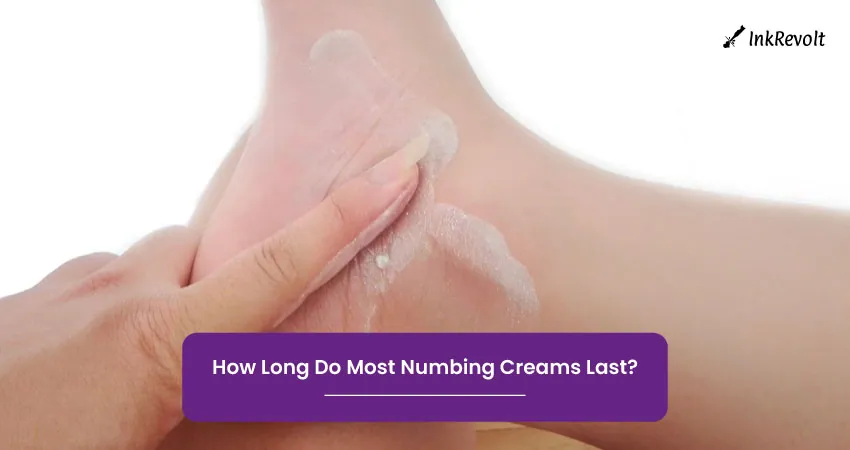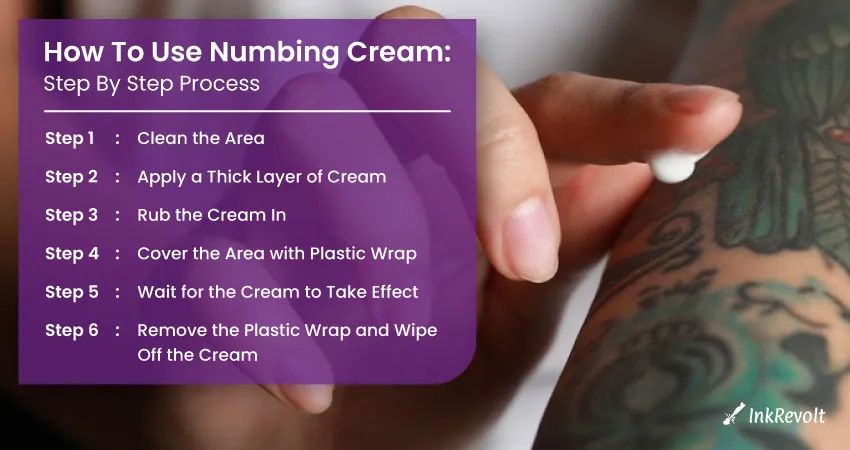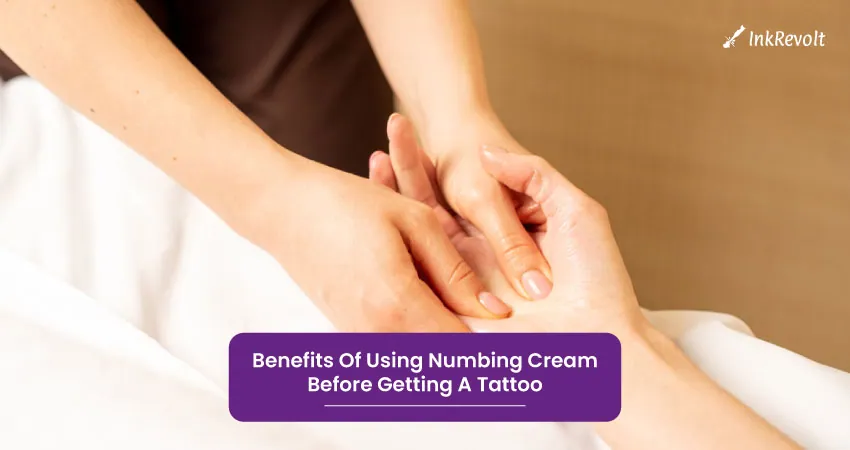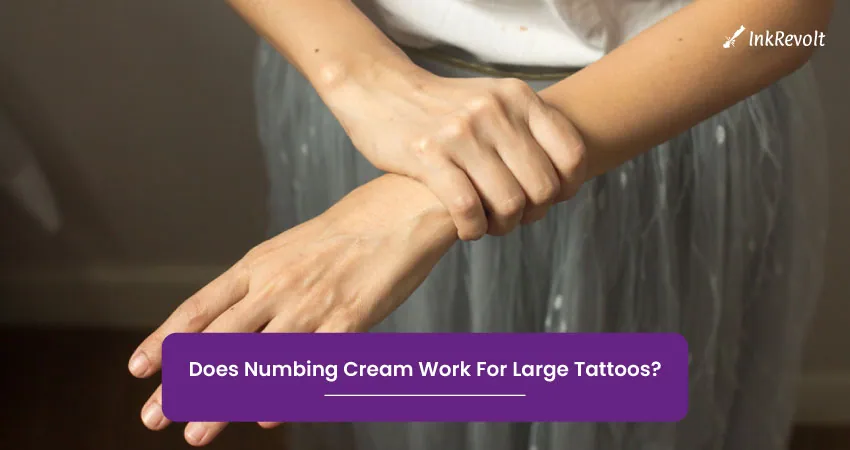Can You Use Numbing Cream Before Getting A Tattoo?
Tattooing is a painful process that involves needles penetrating the skin repeatedly. This pain can be unbearable for some individuals, and as a result, numbing creams have become a popular solution. But can you use numbing cream before getting a tattoo?
Yes, you can but it’s important to do your research and consult with your tattoo artist before applying any numbing cream. While it can help reduce pain during the tattooing process, it can also affect the quality of the tattoo and make it more difficult for the artist to see the skin.
Some creams also contain ingredients that can cause adverse reactions, so be sure to choose a reputable brand and follow the instructions carefully. Ultimately, it’s up to you and your artist to decide if numbing cream is the right choice for your tattoo experience.
In this article, we will explore the pros and cons of using numbing creams, their effectiveness, and any potential risks associated with their use. So, if you’re considering using a numbing cream before your next tattoo session, keep reading to find out all you need to know.
Is It Bad To Put Numbing Cream On Before Getting A Tattoo?

It’s not bad, of course. Numbing cream is a topical anaesthetic that contains lidocaine, tetracaine, benzocaine, or prilocaine, which works by blocking the nerve endings in the skin, reducing the pain sensation.
However, while some people prefer to use numbing cream to minimize the discomfort associated with getting a tattoo, there are some potential drawbacks to consider:
- The effectiveness of numbing cream can vary: The degree of numbing effect can vary depending on factors such as the potency and quality of the cream, the thickness of the skin, and the location of the tattoo. Some people may experience incomplete numbing or even allergic reactions to the cream.
- Numbing cream can interfere with the tattooing process: A tattoo artist needs to feel the resistance and texture of the skin to make accurate and precise lines and shades. If the skin is too numb, the artist may have difficulty controlling the needle, resulting in uneven lines, overworking the skin, or missing the desired effect.
- Numbing cream can delay the healing process: The skin needs to react to the tattooing process to heal properly. When the skin is numbed, the blood vessels may constrict, reducing the oxygen and nutrient supply to the skin, slowing down the healing process, and increasing the risk of infection.
- Numbing cream can mask potential health issues: Pain is a natural warning signal that alerts us to potential health issues, such as infections, allergic reactions, or skin conditions. By using numbing cream, we may be masking the underlying problems and delaying the diagnosis and treatment.
While numbing cream can provide some temporary relief from pain during the tattooing process, it may also have potential risks and drawbacks.
It is always essential to consult with a tattoo artist or a medical professional before using any numbing cream and to follow the instructions carefully. Ultimately, the decision to use numbing cream or not is a personal choice that should consider the potential benefits and risks.
How Long Do Most Numbing Creams Last?

In general, most numbing creams last for about 30 minutes to two hours after application. However, some may last for up to four hours or more.
It’s important to note that the effectiveness and duration of numbing creams can be affected by a number of factors, including
- Skin type: People with thicker or more oily skin may require a higher concentration of active ingredients to achieve the desired effect.
- Area of application: Numbing creams tend to be less effective on areas of the body that are highly vascularized or have a high concentration of nerve endings, such as the face or genitals.
- Concentration of active ingredients: Higher concentrations of active ingredients typically provide longer-lasting effects.
- Application technique: Proper application of the cream can affect its efficacy, as can the amount of cream applied and the length of time it is left on the skin.
In addition to these factors, it’s important to follow the instructions for use provided with the specific numbing cream you are using. Overuse or misuse of these products can lead to adverse effects such as skin irritation, allergic reactions, or systemic toxicity.
How To Use Numbing Cream: Step By Step Process

Numbing creams are a great way to reduce pain and discomfort during certain medical and cosmetic procedures. However, it is important to use them correctly to ensure their maximum effectiveness and minimize any potential risks or side effects.
Here is a step-by-step guide on how to use numbing cream:
Step 1: Clean the Area
Before applying the numbing cream, it is essential to clean the area you intend to treat. Use gentle soap and water to remove any dirt or oil, and dry the area with a clean towel.
Step 2: Apply a Thick Layer of Cream
Apply a thick layer of numbing cream to the area you intend to treat. Be sure to use enough cream to cover the entire area.
Step 3: Rub the Cream In
Rub the cream into the skin gently in a circular motion. This will help the cream penetrate the skin and ensure even distribution.
Step 4: Cover the Area with Plastic Wrap
Once you have applied the cream and rubbed it in, cover the area with plastic wrap. This will help to keep the cream in place and prevent it from drying out.
Step 5: Wait for the Cream to Take Effect
The amount of time it takes for the cream to take effect can vary depending on the product you are using. Typically, it takes between 15 and 30 minutes for the cream to reach its full numbing effect.
Step 6: Remove the Plastic Wrap and Wipe Off the Cream
Once the cream has taken effect, remove the plastic wrap and wipe off any excess cream with a clean towel. Your skin should now be numb and ready for treatment.
It is important to follow the instructions provided with your numbing cream to ensure safe and effective use. Some products may require additional steps or precautions, so be sure to read the label carefully before use.
Benefits Of Using Numbing Cream Before Getting A Tattoo

If you’re curious about why a lot of people prefer using a numbing cream before getting tattoos, below are some benefits of using numbing cream before getting a tattoo:
- Reduces Pain: Tattooing is a painful process that involves puncturing the skin with a needle to inject ink into the dermis layer. The use of numbing cream can help to reduce the pain associated with the procedure, making it more tolerable for the patient.
- Reduces Anxiety: Many people experience anxiety and fear before getting a tattoo, especially if it’s their first time. Numbing cream can help to calm the nerves and reduce anxiety, making the experience less stressful.
- Increases Tolerance: By reducing pain and anxiety, numbing cream can increase the patient’s tolerance for longer tattoo sessions. This is especially important for larger or more complex tattoos that require multiple sessions.
- Improves the Quality of the Tattoo: When a person is in pain or uncomfortable, they may move or flinch during the tattooing process, which can result in an uneven or poorly executed tattoo. By using numbing cream, the patient can remain still and relaxed, allowing the tattoo artist to work more efficiently and produce a better quality tattoo.
- Speeds Up the Healing Process: Numbing cream can also help to speed up the healing process by reducing inflammation and irritation at the tattoo site. This can help to prevent infection and promote faster healing, allowing the patient to enjoy their new tattoo sooner.
What Are The Potential Risks Of Using Numbing Creams?

While numbing creams can be a useful tool for managing pain or discomfort, there are some potential risks associated with their use. Some of these risks include
Skin irritation
Numbing creams can cause skin irritation, redness, or a rash at the site of application. This can be especially true for people with sensitive skin, or for those who use numbing creams frequently or for extended periods of time.
Allergic reactions
Some people may be allergic to the active ingredients in numbing creams, which can cause symptoms such as hives, swelling, or difficulty breathing. It’s important to be aware of the signs of an allergic reaction and to seek medical attention if you experience any of these symptoms.
Overdose or systemic toxicity
Overuse or misuse of numbing creams can lead to systemic toxicity, which can cause symptoms such as dizziness, headache, nausea, or even seizures. It’s important to follow the instructions for use provided with the specific numbing cream you are using and to never exceed the recommended dose or application time.
Interactions with other medications
Numbing creams can interact with other medications, especially those that are absorbed through the skin. It’s important to consult with a healthcare professional before using a numbing cream if you are taking other medications or have any underlying medical conditions.
Reduced sensation
Numbing creams can reduce sensation at the site of application, which can increase the risk of injury or burns if the skin is exposed to heat or other sources of injury.
Does Numbing Cream Work For Large Tattoos?

For large tattoos, numbing creams can be useful in reducing pain and discomfort during the process, especially in areas where the skin is particularly sensitive, such as the ribs, chest, and lower back.
However, the effectiveness of numbing creams may vary depending on several factors, including the type of cream used, the concentration of the active ingredient, the thickness and sensitivity of the skin, and the individual’s pain threshold.
Some people may find that numbing creams provide only temporary relief, while others may not feel any difference at all.
Moreover, it’s worth noting that numbing creams may have side effects such as skin irritation, allergic reactions, and interference with the healing process, which is why it’s important to consult with a licensed tattoo artist or a healthcare professional before using any numbing cream.
To sum up, numbing creams can be a helpful tool for reducing pain and discomfort during large tattoos, but their effectiveness depends on various factors and individual responses.]
It’s essential to weigh the benefits and risks of using numbing creams and to follow the recommended guidelines and precautions to minimize the chances of adverse effects.
What Are Some Recommended Numbing Creams For Tattoo Treatments?

Below are some of our recommendations for choosing numbing creams for your tattoo. Let’s check them out.
| Product Name | Key Ingredients | Why is it best for tattoo treatments? | Price range |
| Ebanel Numb520 | Lidocaine, Prilocaine, Benzocaine | Provides fast and effective numbing for up to 3 hours, perfect for long tattoo sessions | $28-$35 |
| Zensa Numbing Cream | 5% Lidocaine | Made with all-natural ingredients and provides up to 2 hours of numbing, reducing discomfort during tattoo treatments | $40-$50 |
| Uber Numb | 5% Lidocaine | Offers a numbing effect for up to 4 hours and is water-based, making it easy to apply and remove | $25-$30 |
| Hush Anesthetic | 4% Lidocaine | Provides a long-lasting numbing effect for up to 4 hours and is vegan-friendly and cruelty-free | $30-$40 |
| Dr. Numb | 5% Lidocaine | Provides fast and long-lasting numbing for up to 4 hours, making it perfect for tattoo treatments | $45-$55 |
Ebanel Numb520 is a fast-acting and long-lasting numbing cream that is ideal for larger tattoos. Zensa Numbing Cream is hypoallergenic, safe for sensitive skin, and provides long-lasting relief. Uber Numb works quickly and effectively to numb the skin.
Hush Anesthetic reduces pain, inflammation, and redness. Dr Numb has a high concentration of numbing agents, making it an ideal choice for maximum pain relief.
When choosing a numbing cream for tattoo treatments, it is important to consider factors such as the size of the tattoo, skin sensitivity, and the concentration of the numbing agents.
The price range may also be a consideration for some individuals. By comparing the key features of these five options, individuals can make an informed decision about which numbing cream is best for their needs.
Alternative Options To Numbing Cream
There are several alternatives to numbing creams that can be used to manage pain or discomfort. Some of these alternatives include
- Ice or cold packs: Applying ice or a cold pack to the site of pain can help reduce inflammation and numb the area. This can be especially effective for acute injuries such as sprains or strains.
- Heat therapy: Applying heat to the site of pain can help increase blood flow and reduce stiffness or muscle tension. This can be especially effective for chronic pain conditions such as arthritis.
- Acupuncture: Acupuncture is a traditional Chinese medicine practice that involves inserting fine needles into specific points on the body. This can help reduce pain and inflammation and promote healing.
- Massage therapy: Massage therapy can help reduce muscle tension, improve circulation, and promote relaxation. This can be especially effective for chronic pain conditions such as fibromyalgia.
- Distraction techniques: Distraction techniques such as listening to music, reading a book, or engaging in a hobby can help take your mind off of the pain and reduce discomfort.
- Mind-body techniques: Mind-body techniques such as meditation, deep breathing, or yoga can help reduce stress and promote relaxation. This can be especially effective for chronic pain conditions that are exacerbated by stress.
- Medications: Over-the-counter pain relievers such as acetaminophen or ibuprofen can be effective for managing mild to moderate pain. Prescription pain medications may be necessary for more severe pain conditions, but should be used with caution and under the guidance of a healthcare professional.
Frequently Asked Questions
Can I use any type of numbing cream before getting a tattoo?
Not all numbing creams are suitable for use before getting a tattoo. It’s important to choose a cream that is specifically formulated for use on the skin and that contains safe and effective active ingredients. It’s also important to choose a cream that is safe for use around the eyes, as tattoos around the eyes can be particularly sensitive.
How long does numbing cream last during a tattoo session?
The duration of action of numbing cream can vary depending on the specific type of cream, the concentration of active ingredients, and the individual’s skin type and sensitivity.
In general, most numbing creams last for about 30 minutes to two hours after application. It’s important to follow the instructions for use provided with the specific numbing cream you are using and to never exceed the recommended dose or application time.
Will using numbing cream affect the quality of my tattoo?
Using numbing cream before getting a tattoo may not affect the quality of the tattoo itself, but it can make it more difficult for the tattoo artist to see the skin and ensure the accurate placement of the tattoo. It’s important to discuss your use of numbing cream with the tattoo artist before the tattooing process begins.
Last Words
Using numbing cream before getting a tattoo is a personal choice and can be a helpful option for individuals who are concerned about pain or discomfort during the process.
However, it’s important to be aware of the potential risks associated with the use of numbing creams, including skin irritation, allergic reactions, and systemic toxicity. Make sure you follow the instructions for use provided with the specific numbing cream you are using and to consult with a healthcare professional before using a numbing cream.
